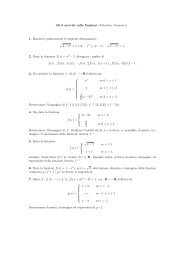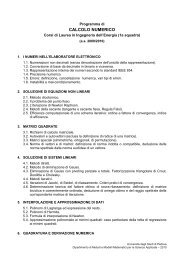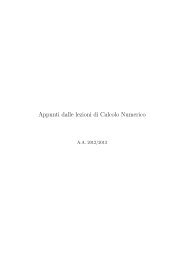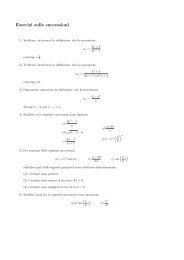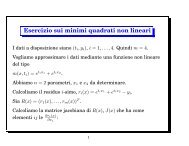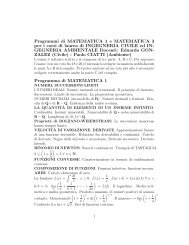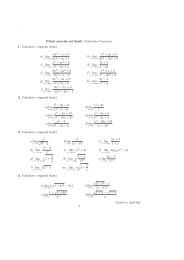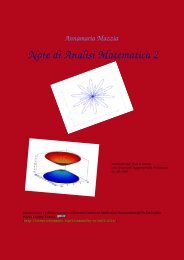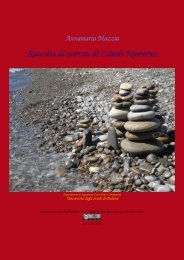Note di Analisi Matematica 2 - Esercizi e Dispense - Università degli ...
Note di Analisi Matematica 2 - Esercizi e Dispense - Università degli ...
Note di Analisi Matematica 2 - Esercizi e Dispense - Università degli ...
Create successful ePaper yourself
Turn your PDF publications into a flip-book with our unique Google optimized e-Paper software.
1. BREVI RICHIAMI DI ANALISI 1<br />
cos (−θ) = cos (θ)<br />
cos ( π 2<br />
− θ) = sin (θ)<br />
sin<br />
cos ( π 2<br />
+ θ) = − sin (θ)<br />
sin<br />
cos (π − θ) = − cos (θ)<br />
cos (π + θ) = − cos (θ)<br />
cos (θ + φ) = cos (θ) cos (φ) − sin (θ) sin (φ)<br />
sin (2θ) = 2 sin (θ) cos (θ)<br />
sin 2 (θ) + cos 2 (θ) = 1<br />
sin (−θ) = − sin (θ)<br />
( π<br />
2<br />
− θ) = cos (θ)<br />
( π<br />
2<br />
+ θ) = cos (θ)<br />
sin (π − θ) = sin (θ)<br />
sin (π + θ) = − sin (θ)<br />
sin (θ + φ) = sin (θ) cos (φ) + cos (θ) sin (φ)<br />
cos (2θ) = cos 2 (θ) − sin 2 (θ)<br />
tan 2 (θ) + 1 = sec 2 (θ)<br />
1.3 Regole su funzione esponenziale e logaritmica<br />
Assumiano a, b ∈ R, con a > 0 e b > 0. Si ha:<br />
1 x = 1<br />
a x+y = a x a y<br />
a xy = (a x ) y<br />
a log a (x) = x a 0 = 1<br />
a x−y = a x /a y<br />
a x b x = (ab) x<br />
log a (xy) = log a (x) + log a (y) log a (x/y) = log a (x) − log a (y)<br />
log a (x y ) = y log a (x)<br />
log a (a x ) = x<br />
log b (x) = log a (x)<br />
log a (b)<br />
b x = a x log a (b)<br />
1.4 Derivate e integrali<br />
Siano f e g due funzioni <strong>di</strong>pendenti dalla variabile reale x mentre c ∈ R sia una costante.<br />
In<strong>di</strong>chiamo la derivata <strong>di</strong> f con il simbolo df<br />
dx o me<strong>di</strong>ante f ′ . Si ha:<br />
d (cf)<br />
d x = cf ′ regola della costante<br />
d (f + g)<br />
= d f<br />
d x + d g<br />
d x<br />
regola della somma<br />
d x<br />
d (f/g)<br />
= f ′ g − fg ′<br />
d x g 2 regola del quoziente<br />
d (fg)<br />
d x = fg′ + f ′ g regola del prodotto<br />
d f r<br />
d x = rf r−1 f ′<br />
regola della potenza<br />
Tra le regole <strong>di</strong> integrazione, invece, ricor<strong>di</strong>amo quella <strong>di</strong> integrazione per parti:<br />
∫<br />
∫<br />
fg ′ dx = fg − f ′ g dx<br />
Diamo ora una tabella delle derivate e <strong>degli</strong> integrali delle funzioni più note (per gli integrali<br />
lasciamo fuori la costante <strong>di</strong> integrazione), e con la simbologia arcsin(x) ≡ arcoseno(x),<br />
arccos(x) ≡ arcocoseno(x), cot(x) ≡ cotangente (x), arctan(x) ≡ arcotangente(x), arccot(x) ≡,<br />
arcocotangente(x).<br />
2



